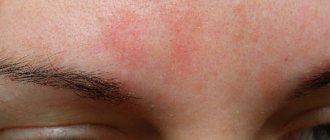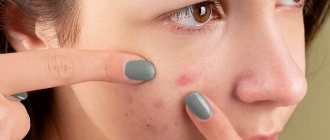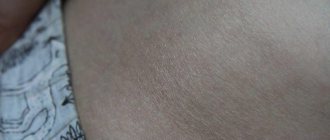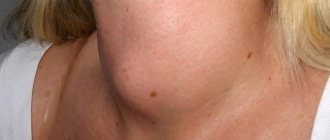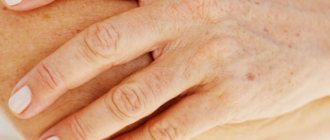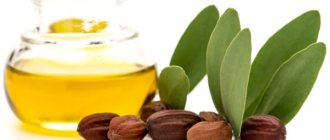July 5, 2020
Dry patches on the skin are a common dermatological symptom that can indicate either a temporary failure and disruption of the barrier functions of the epidermis, or a skin disease. It all depends on the size of the spots, the clarity of their boundaries, as well as the duration of their presence on the skin.
The causes of dryness can be divided into two large groups:
- nonspecific - allergic reactions to household chemicals, laundry soap, cosmetic products, dehydration due to cold and wind;
- specific - then the spots become a manifestation of dermatological diseases.
Sometimes a person himself may notice that dry spots appear on his skin after a certain event occurs, for example, after washing clothes by hand. Then the reason is obvious and easy to eliminate. But if dry spots on the skin do not go away, they itch, or flake, you should consult a doctor.
Red spots
This type is the most common. They have the following features:
- The appearance of spots accompanied by itchy skin may be the result of a dermatological or fungal disease.
- Red spots, which are combined with the development of skin itching and flaking, may be the result of dermatitis, lichen or eczema.
- Small spots with a dark red or crimson tint appear against the background of chickenpox, measles and meningitis. Itching during illness can be unbearable.
- Red spots on healthy skin are the result of allergic reactions.
- Stress exposure is characterized by the appearance of diffuse dark red and burgundy spots in the neck or chest area. Their disappearance is observed after calming down.
Types of pigment spots and methods for their removal
Pigment spots can be small, large, single or multiple. They can have different shapes, usually close to oval, and different colors from light red to dark brown. The most common age spots are freckles, birthmarks and age-related pigmentation.
Freckles. This type of pigmentation is characteristic of fair-skinned people. Freckles usually appear on exposed areas of the body - the face, arms, ears, upper back and chest. Their color changes depending on the intensity of the sun. It is believed that freckles are caused by an uneven distribution of pigment in the skin, so over time, when the body gets stronger and adapts, they fade or disappear completely. For many girls, especially red-haired ones, freckles suit them - they add individuality, but this is not always the case. Too contrasting and extensive pigmentation is a reason for complexes, so they are “taken out”.
There are different ways to remove freckles. Traditional medicine, for example, recommends using parsley juice to whiten the skin. Of course, this method will not work immediately - it will take several months. Cosmetology offers much more effective methods. You can quickly remove freckles using chemical peeling with a base of fruit or lactic acids or laser skin resurfacing.
Birthmarks. Moles (nevi) can form on any part of the body. They have an even shape and a rather dark color. Unlike freckles, the melanin that forms the pigment spot is located in several layers of the skin, so removing a mole is more difficult than freckles. Moles have one peculiarity - they can degenerate into cancer, so large and suspicious formations are recommended to be removed. Birthmarks located in places of contact with the seams of clothing, belts and in areas subject to shaving are also removed. An injured mole is a gateway to infection: it can become inflamed, bleed and become wet.
A direct indication for contacting the clinic is a change in the shape, volume and color of the birthmark. Black and asymmetrical moles, bleeding or flaky spots with cracks are especially dangerous.
Moles without signs of cancer are removed with liquid nitrogen, diathermocoagulation or laser. Laser removal of birthmarks is most preferable, since it does not injure surrounding tissues and does not leave scars. And removing moles with a laser does not hurt at all, which is why many patients choose this particular technique.
Age spots. Unfortunately, these signs of impending old age cannot be prevented. Lentigo, as this type of pigmentation is called, appears in people after 40 years of age. Such age spots are especially noticeable during menopause, when pigmentation is spurred by hormonal changes. Lentigines, like freckles, are localized in places where the skin has been exposed to constant sunlight - on the face, arms, chest and back. Women, noticing such pigmentation, are upset, because they cannot hide the brown spots and they clearly show their age.
Age-related pigmentation can only be removed using cosmetic methods - traditional medicine will not help here. You can try medium or deep chemical peeling or low-impact laser removal. The advantage of the latter method is undeniable - after the procedure, only slight redness remains at the site of the spots, which quickly passes. With deep chemical peeling, the cosmetologist completely removes the top layer of skin, so recovery will take at least a month.
Large pigment spots. Melasma is a significant cosmetic problem. Unlike moles, such age spots have an uneven shape and look very unattractive. Their color intensifies in the sun - in spring and summer, and in winter the pigmentation decreases. Large pigment spots are a sign of hormonal changes, so they often occur during pregnancy, taking hormones, and the onset of menopause.
Large age spots can go away on their own, but women do not want to wait for this moment, so many resort to the help of a cosmetologist. Light peeling, special whitening masks, laser skin resurfacing, etc. can reduce the color of such spots.
Pink spots
The appearance of pink spots may be associated with atopic dermatitis, which is the result of contact with dust particles, chemicals or various products. An unstable psycho-emotional state is accompanied by the appearance of spots on the chest, neck, face, and arms.
Against the background of zhiber, the patient is bothered by pink spots localized in the back or hips. Activation of the disease is associated with a decrease in immune strength after illnesses of an infectious nature.
The appearance of ringworm is associated with damage to the skin and hair loss.
Only a dermatologist can make a diagnosis based on an external examination, assessment of color, size or shape. Based on the diagnostic results, the optimal treatment method is selected. If necessary, a consultation with specialists such as a venereologist or oncologist is scheduled.
Causes of age spots
The color of human skin depends on the concentration of pigments. A lack or excess of melanin, carotene and other pigment substances leads to the formation of pigment spots of different colors and sizes. Discolored patches of skin may be congenital or appear with age. Ultraviolet light often triggers the process - when tanning in the sun or in a solarium. This is because melanin, which gives the brown color, protects the skin from the effects of ultraviolet radiation. The more it gets on the skin, the more melanin is produced.
There are many other reasons why pigment spots form on the face and body. Often this is a consequence of serious disorders in the body. Therefore, if you notice new age spots, you should consult a doctor. The production of pigments is enhanced by:
- Natural and premature aging.
- Hormonal problems associated with thyroid diseases, pituitary tumors.
- Liver diseases.
- Neuropsychiatric disorders.
- Vitamin deficiency, metabolic disorder.
- Gynecological diseases.
Medicines and cosmetics can provoke the problem. Also, age spots are not uncommon during pregnancy.
Do not confuse pigment spots and malignant skin tumors - these are completely different processes. If pigment spots can be left untouched or removed, and in both cases this will not affect general health, then oncological formations require long-term, serious treatment.
Solving the problem yourself
Temporary, or transient, redness of the facial skin is not considered a pathology. It disappears on its own and does not cause much discomfort other than psychological. To remove occasional cases of hyperemia on your own, you should follow simple steps:
- Remove the irritating factor
. Change the environment, wash off the allergen or toxic substance from the surface of the skin, try to calm down. - Restore natural skin color
. Folk remedies and herbal remedies help with this. You must first make sure that you are not allergic to the components. - Take care to strengthen the protective barrier
. To do this, it is advisable to carry out a set of measures aimed at improving the health of the body as a whole and maintaining the functional properties of the skin.
The following recommendations can also help get rid of a red face, but will require a long time and lifestyle adjustments.
Gentle cleansing and care.
You should wash your face with warm water, without contrasting temperatures, and dry with a soft towel with light blotting movements.
Prevention of infections.
An important rule is to never touch your face with your hands unnecessarily. The habit of removing pimples yourself can lead to infection not only local, but also general. Even with minor damage and scratches, it is worth immediately treating the area of microtrauma with an aseptic substance.
Lifestyle.
The diet must contain foods rich in fiber and vitamins.
It is worth avoiding the consumption of salty foods, smoked meats, spicy seasonings and alcohol. Good sleep and a calm microclimate also help remove redness on the face. Caring cosmetics.
The beauty industry provides a wide range of cleansing, lipid-restoring and healing products. It can be difficult to understand them on your own, however, dermatologists recommend not to get carried away with cosmetics based on alcohol solutions and to carefully choose them. Individual consultation
Pigmentation or hyperpigmentation of the skin - what is it?
In fact, there is nothing wrong with this term and such a defect has absolutely nothing to do with any diseases.
The dictionary definition states that this can be called the uneven distribution of coloring pigments over the surface of the epidermis. In our case, we are talking specifically about a substance such as melanin, produced by a certain type of cell (melanocytes). Excessive accumulation or deficiency can cause hyperpigmentation or, conversely, tissue discoloration. This is how dots and even extensive formations appear, which are clearly visible to the naked eye. However, not only this substance has coloring ability; there are others. These can be lipochromes, bilirubin, lipofuscin and many others, which are products of cell metabolism.
Disease prevention
Prevention of eczema consists of following a hypoallergenic diet. It is important to abandon all factors that can provoke exacerbations. Pay attention to personal hygiene and do not use cosmetics containing chemicals or synthetic substances. Eliminate any stressful situations and lead a healthy lifestyle.
Eczema is a chronic disease that causes not only physical but also psychological discomfort and worsens a person’s quality of life. Early diagnosis, proper treatment and compliance with medical recommendations will help keep the disease under control, reduce the frequency of exacerbations, and minimize complications.
Allergies to foods and medications
Food allergies on the face are quite common, especially in children. The most allergenic foods are peanuts, eggs, seafood, citrus fruits, and dairy products. However, in the presence of individual intolerance, an allergy can develop to any other food product.
Main symptoms:
- blotchy rash on the face or body;
- Severe itching;
- Peeling of the skin;
- Nausea, vomiting;
- Stool disorders;
- Abdominal pain.
Another important problem is drug allergies. An allergic reaction may occur to a medicine in the form of a tablet, injection, or ointment. Allergies to antibiotics, antiseptics, and nonsteroidal anti-inflammatory drugs are common. The symptoms are the same as those of a food allergy. In severe cases, complications such as angioedema or anaphylactic shock may develop2. You need to know what drugs you are allergic to and warn doctors or medical staff about it.
Features of treatment
Treatment of skin diseases of an allergic nature requires an integrated approach. First of all, therapy should be aimed at the absolute exclusion of harmful pathogens, as well as at improving symptoms. Itching, swelling and redness cause patients severe discomfort, both physiological and emotional. Itchy spots make it difficult to sleep and work fully. In addition, the affected areas disrupt the aesthetics of the skin, so patients often hide them under clothing, which can only aggravate the situation. In addition, allergic reactions on the skin cannot be wetted, so patients are deprived of the opportunity to take a bath, visit the pool or sauna.
To eliminate a rash on the hands, it is necessary to use topical external agents in the form of ointments or creams. In the treatment of allergic dermatoses, drugs based on topical glucocorticosteroids have proven themselves to be effective.[10] Such products have wide application possibilities, since they have several effects on the inflammatory focus:
- anti-inflammatory effect;
- antiallergic effect;
- vasoconstrictor properties;
- antipruritic effect.
One of the representatives of local glucocorticosteroids prescribed for the treatment of allergic dermatoses are the drugs "Akriderm GK".
